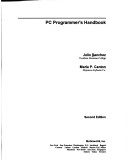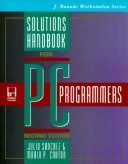J.Ranade Workstation S.
4 total works
This programmer's reference is an all-in-one handbook of technical data and programming routines for IBM and compatible computers. It is designed for software developers, application developers and programmers on IBM and compatible microcomputers. Contents include systems descriptions and technical data for microprocessors, programmable hardware, BIOS services, serial communications and printer programming, auxiliary storage, all input devices and video hardware. The second edition features data on hardware developments and operating systems releases, plus expanded coverage of mouse hardware and mouse programming. Current information on portable, lap-top and notebook computers; IBM micro and compatible models; the PS/1 and PS/ValuePoint lines; ISA and EISA architectures; and SuperVGA and XGA graphics is also provided. The work also contains a special discount coupon for a microdisk available from the authors, which includes routines, templates and libraries that can be used in C, Pascal, BASIC and assembly language.
For 386, 386SX, and 486 PC power users, this book/disk combination offers detailed programming examples that enhance IBM's XGA graphics capability. It offers a technical tutorial on programming the XGA system using Adapter Interface (AI) software. The 3.5" disk is usable from C, Pascal, BASIC, and Assembler language. Detailed discussions of XGA features and characteristics, including a technical description of XGA architecture and components, are included. Also highlighted are the importance and usefulness of the XGA graphics coprocessor and its advantages in programming the XGA system. Other features include: direct access to XGA hardware; animation techniques; bitblt and sprite operations; a value-added diskette that contains not only code samples, but also an extensive XGA programming library that can be used from C, Pascal, BASIC, and Assembler; screen panning; geometrical transformations; and much more.
In less than ten years, microcomputer graphics hardware has progressed from primitive, low-definition systems to systems able to provide photographic quality imaging, high-resolution video, and more. With this capability has come increased complexity and programming complications. This book explores the most recent IBM PC graphics features and provides detailed guidelines on the low-level programming of graphics devices. It includes information on how to: use XGA and Super VGA video modes in programmes; programme laser printers using HP-PCL; implement the latest pen plotter and image scanning technologies; develop and use bit-mapped fonts; scan, encode, and compress graphics images using the Tag Image File Format (TIFF); create real-time animation using image data structures and geometric transformations; prepare screen-to-print and slide-to-screen transfers; and much more. In addition, the accompanying 3 1/2" disk provides a set of VGA, XGA, and Super VGA device drivers, a TIFF file reader, a colour-separation dump programme, a collection of pen plotter primitives, and other ready-to-use utilities that can be implemented by C, Pascal, BASIC, and assembler programmes.
Solutions Handbook for PC Programmers
by Julio Sanchez and Maria P. Canton
Published 1 November 1995
Recent technological changes, as well as shifts in programmer interests, are addressed in this complete guide to today's solutions for programmers. Featuring forty percent new information, this second edition features up-to-date information on sound programming, CD-ROM programming, video animation in VGA Mode X, parsing, and more.


